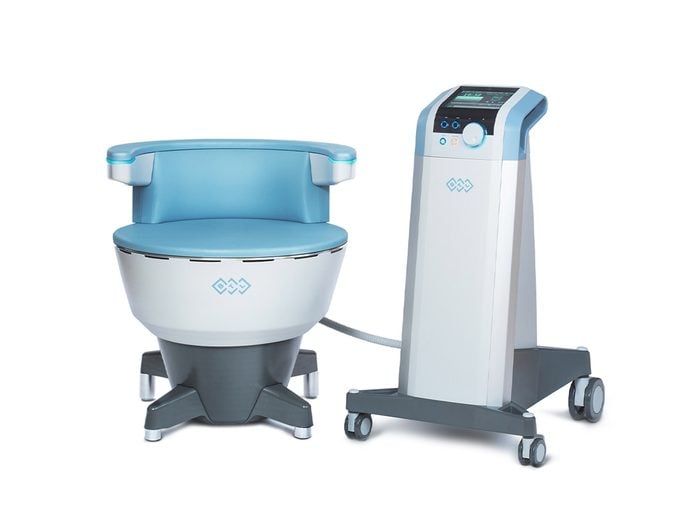Can a Kegel Chair (Yes, a Kegel Chair) Improve Your Pelvic Health?

We tried Emsella, a chair that can do 11,000 Kegels in one session.
I love riding my girlfriend Emsella at the doctor’s office. Twice a week for three weeks, I zip into a little room at Compass Dermatology in Toronto, close the door and straddle what looks like an overturned dome. I sit astride her like a jaunty cowgirl, and when I emerge 28 minutes later, I’ve “done” 11,000 Kegels and my pelvic floor is practically 20 years old again (okay, fine—23 years old!).
“The Kegel Throne” or, its official name, Emsella, is a powder-blue chair supercharged with technology that stimulates pelvic floor muscles with high-intensity focused electromagnetic energy to help treat incontinence. The co-founder of Compass, dermatologist Julia Carroll, brought it into her practice after she had success using it herself.
“I’m a woman over 40 who has had a child, so you do the math,” she says wryly. “Fifty-year-olds should not be wearing diapers! Why do we accept that as women?”
Now Emsella is one of the more popular treatments at her tony midtown clinic, with patients happily forking over about $2,000 for six sessions over three weeks. So when she invites me to try it, I can’t say no.
The Canadian Continence Foundation estimates that 33 percent of women over 40 will deal with some degree of incontinence, and since I had my kid, I’m one of them. While my trusty liquid-absorbing Knix undies have definitely gotten me through more than one unexpected violent sneeze, I’d really like to not have to cross my legs every time I laugh. Could this be the answer to my pelvic prayers?
(Related: We Tried Knix’s Super Leakproof Period Underwear)
The pelvic floor is a group of muscles that sits like a trampoline at the base of your pelvis. It supports your reproductive organs, bladder and rectum, and help control your bladder and bowel movements. While pregnancy and birth can definitely wreak extra havoc on it, even if you haven’t had a baby, the muscles of your pelvic floor will eventually weaken, just like the rest of your old-ass self, if you don’t keep it fit. You can visit specialized pelvic physiotherapists who will consider your overall abdominal, rectal and vaginal health, and seriously get up in your business to help teach you to develop fitness for your floor yourself. But even a superwoman couldn’t do Kegels the way this machine gets you to do Kegels. You sit on it fully clothed, making sure the centre hits you right in the coochie, and the energy the chair provides takes your pelvic floor through a 28-minute fitness program.
“Does it feel…good?” my (obviously thrilled) friend asks.
I wouldn’t say it feels good, but it doesn’t hurt. It’s mostly just deeply weird, kind of like there’s a conga line of termites with tiny rose-gold jackhammers rhythmically drilling up my hoo-ha and into my interior lady region for half an hour.
But why is it being offered by a dermatologist instead of someone who specializes in women’s health? Because it’s an offshoot of Emsculpt, a popular treatment that gives gym bunnies that last little bit of definition in their abs that’s often offered by plastic surgeons and dermatologists, so derms are already familiar with the technology. It’s also an expensive piece of equipment, so it’s not the kind of thing your average friendly neighbourhood pelvic physio can generally afford. But that isn’t to say pelvic professionals are against it.
(Related: The Natural Way To Treat Incontinence)
Sinéad Dufour, a pelvic health physiotherapist and associate clinical professor at McMaster University’s School of Rehabilitation Science, says early studies on Emsella are promising and it can be a useful tool, but it should only be used as part of a holistic and individualized pelvic health regimen that includes a full assessment by someone who works within urogynecology.
“Anything we can do to keep women away from medication or surgery is for the better,” she says. “But if someone is offering this and they don’t have a nurse continence advisor, a physio or anyone who knows anything about urogynecology involved, I would be running for the hills.”
While Carroll takes my gynecological history and makes sure I don’t have any of the standard contraindications, like pregnancy, uterine prolapse, Parkinson’s or any metal implants or IUDs, pacemakers or body piercings (because magnets!), there’s no pelvic examination. Dufour thinks delivering it as a one-size-fits-all approach runs the risk of missing potentially serious underlying conditions or even causing an increase in pelvic pain—not to mention I’m not given any guidance on time-tested methods of treating incontinence, like bladder training, lifestyle changes and at-home exercises.
(Related: Why You Need to Strengthen Your Pelvic Floor Now)
But did it work for me? It clearly does something, because—TMI alert!—after about four sessions, I have to start repositioning where I sit on the toilet, otherwise my newly turbocharged pelvic floor suddenly sprays turbo-pee over the edge of the seat.
Have things drastically improved when my kid jump-scares me at least once a day? Not entirely. But I’m not waking up three times a night to pee anymore, so that’s a win. It’s also much easier to actually feel my newly pumped-up pelvic floor when I do my Kegels, which encourages me to do them more. But not “more” enough, apparently, because as the months pass, without keeping up with a pelvic floor fitness routine, things start to degenerate. Emsella isn’t a stand-alone solution—it’s more like an intense boot camp for your pelvic floor, and, like any muscle, if you don’t use it, you lose it.
It just might be time to visit my girlfriend again. I sure hope she misses me.




